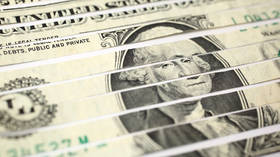Yuan displacing dollar on Moscow Exchange
The share of the Chinese yuan on the Moscow Exchange (MOEX) hit an all-time high in March, the Bank of Russia (CBR) reported in a monthly financial market overview published on Monday.
The yuan accounted for 39% of the total volume of trading in major currencies, up from 37% in February, according to the CBR. Meanwhile, the dollar’s share dropped to 34%, from 36% in the prior month. To compare, the greenback’s share a year ago was 87.6%, while the yuan’s was just 0.32%.
“Market participants continued to reduce the volume of transactions in ‘toxic’ currencies in exchange trading,” the regulator concluded. The dollar, along with the euro, was deemed ‘toxic’ because Ukraine-related Western sanctions against Russia jeopardized the use of these currencies in Russia’s transactions with foreign partners.
Prior to February, the yuan had never outpaced the dollar on MOEX in terms of monthly trading volume. By the end of February, the volume of trading in the ruble-yuan pair amounted to 1.49 trillion rubles ($18.1 billion) against 1.43 trillion ($17.4 billion) in the dollar-ruble pair. In March, turnover in the yuan grew further to 2 trillion rubles ($24.3 billion), against 1.7 trillion rubles ($20.7 billion) worth of transactions with the dollar.
It was also noted that, in contrast to the previous months, Russian citizens significantly increased the volume of yuan purchases, from 11.6 billion rubles in February to 41.9 billion in March. Russian banks offer foreign currency accounts, while foreign currency can also be purchased through banks and money exchanges. Some Russians buy other currencies to hedge against volatility in the ruble.
Analysts say the changes in the yuan and dollar trading volumes reflect Russia’s move away from transacting in the currencies of so-called ‘unfriendly’ countries against the backdrop of sanctions. The restrictions include the blacklisting of a number of Russian banks and their removal from the SWIFT interbank messaging system, as well as bans on transactions with Russian financial entities and the freezing of foreign exchange reserves. In February, Finance Minister Anton Siluanov said the country no longer trusts the US currency, calling it “a completely unreliable instrument.”
More recently, in late March, Russian President Vladimir Putin said the country would have continued to use the dollar, but sanctions forced it to de-dollarize.
“We would use the dollar, but they won’t allow us to do that, so how do we make payments? In a currency that is acceptable to our trading partners. The yuan is one such currency, especially since it is also used by the International Monetary Fund,” the Russian president stated.
For more stories on economy & finance visit RT’s business section






Comments are closed.